A quike guide teaching you how to use matlab to read netCDF file and plot a figure
2. A brief introduce to netCDF. 4
4.1 Get data from netCDF file. 12
4.2 Get subset data of specified variable. 13
Example 1: get the time series of a specified point (lon(11),lat(10))13
Example 2: get data of every point at time(0)14
1. Preparation
Software: Matlab 2014a;
Used netCDF File: example.nc(containd in Matlab Install files), pres.tropp.2015.nc.
Instruction/Reference:
1. Matlab help documention
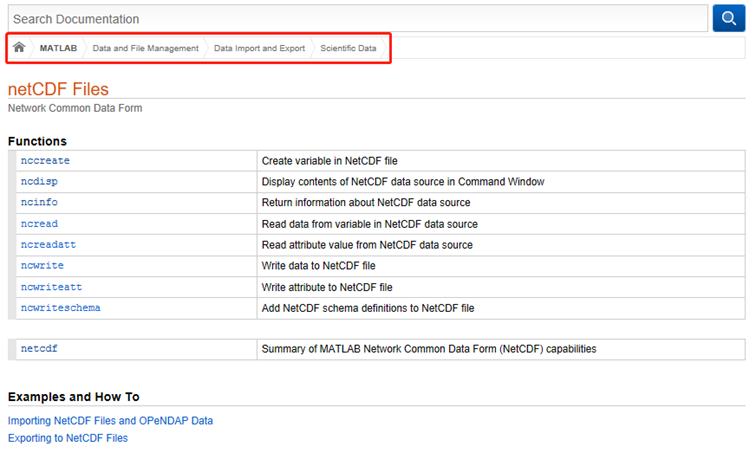
2. NetCDF User's Guide
https://www.unidata.ucar.edu/software/netcdf/old_docs/docs_4_0_1/
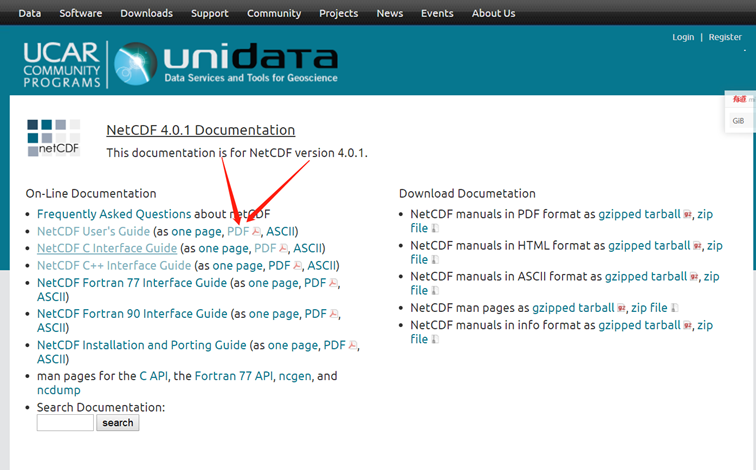
3. NetCDF Documentation
https://www.unidata.ucar.edu/software/netcdf/docs/index.html
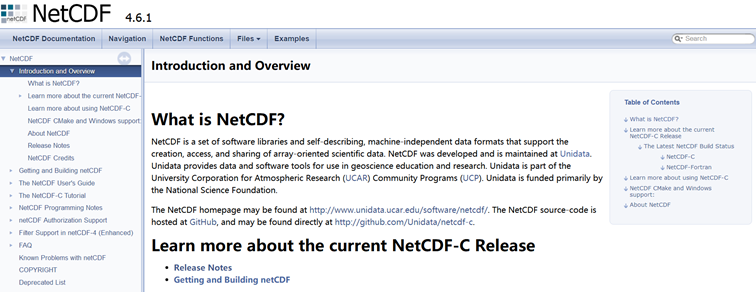
2. A brief introduce to netCDF
NetCDF is a set of software libraries and self-describing, machine-independent data formats that support the creation, access, and sharing of array-oriented scientific data. NetCDF was developed and is maintained at Unidata. Unidata provides data and software tools for use in geoscience education and research.
|
Format |
Model |
Version |
Released Year |
|
Classic format |
classic model |
1.0~3.5 |
1989~2000 |
|
64-bit offset format |
3.6 |
2004 |
|
|
netCDF-4 classic model format |
|||
|
enhanced model (netCDF-4 data model) |
4.0 |
2008 |
|
|
netCDF-4 format |
l data represented with the classic model can also be represented using the enhanced model;
l datasets that use features of the enhanced model, such as user-defined nested data types, cannot be represented with the classic model;
l Evolution will continue the commitment to keep the Backwards Compatibility;
n Backwards means the “previous” and Forwards means the “future”;
l Knowledge of format details is not required to read or write netCDF datasets, unless you want to understand the performance issues related to disk or server access.
l The netCDF reference library, developed and supported by Unidata, is written in C,with Fortran77, Fortran90, and C++ interfaces. A number of community and commercially supported interfaces to other languages are also available, including IDL, Matlab, Perl,Python, and Ruby. An independent implementation, also developed and supported by Unidata, is written entirely in Java.
3. Data Structure
By use of the “ncinfo” we can get the structure information of the data source. This information is store in the Workspace. You can also use “ncdisp” to display the contents of the netCDF file in the Command Window.
|
structure1 = ncinfo('example.nc'); |
structure2 = ncinfo('pres.tropp.2015.nc'); |
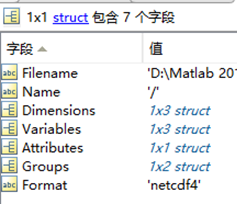 |
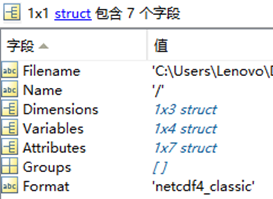 |
If we sort the data, we can get:
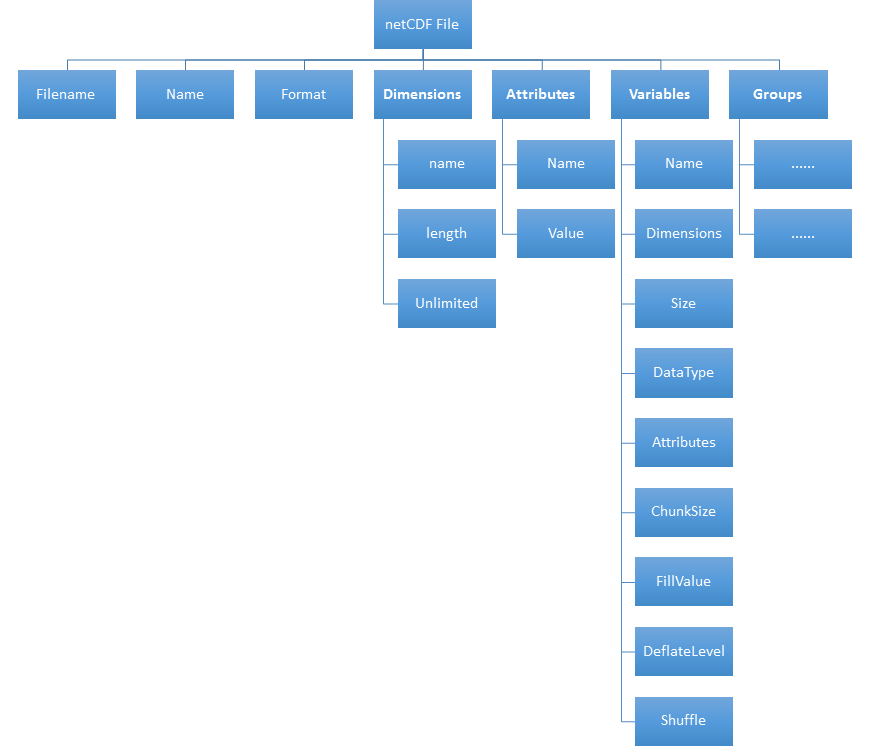
l Filename: netCDF file name or URL.
l Name: “/” indicating the full file
l Format: the format of the netCDF file, see section 2.
l Groups: An empty array([]) for all netCDF file format except netCDF-4 format.
3.1 Attributes
概述:File有attributes,variable有attributes;就近原则,描述自己。
NetCDF attributes are used to store data about the data (ancillary data or metadata(元数据,描述数据的数据)), we can call them Global Attributes.
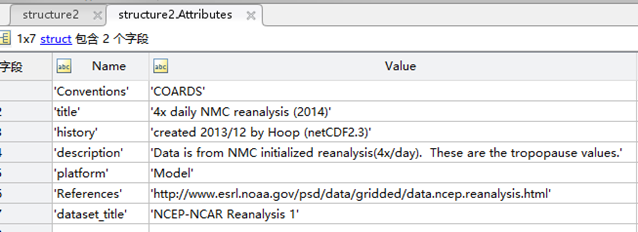
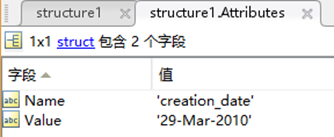
Most attributes provide information about a specific variable. These are identified by the name (or ID) of that variable, together with the name of the attribute.
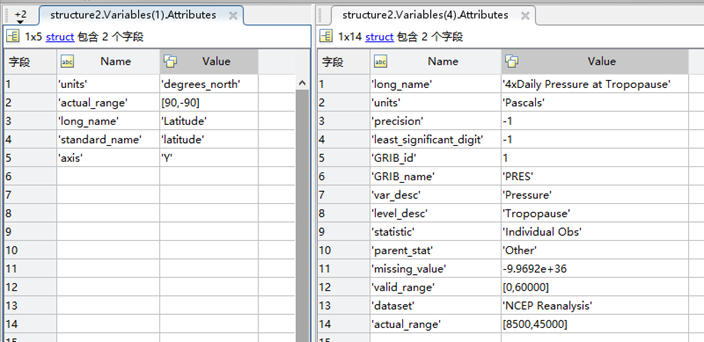
3.2 Dimensions
A dimension may be used to represent a real physical dimension, for example, time, latitude, longitude, or height. A dimension might also be used to index other quantities, for example station or People.
l Name: the name of the dimension;
l Length: number(sample) of values;
l Unlimited: Boolean value. Indicates whether this dimension’s length is limited.
In a classic or 64-bit offset format dataset you can have at most one UNLIMITED dimension;
In a netCDF-4 format dataset, multiple UNLIMITED dimensions can be used.
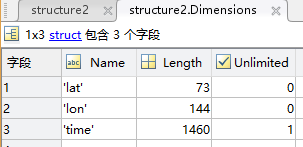
3.3 Variables
When a variable is defined, its shape is specified as a list of dimensions. These dimensions must already exist.
A scalar has no dimension, a vector has one dimension and a matrix has 2 dimensions.

l Dimensions: the same as “independent variables”.

l Size: Like the matlab function “size” if the variable is matrix, like the matlab function “length” if the variable is verctor or scalar.
l Attributes: see section 3.1
l ChunkSize: specifying the size of one chunk. If the storage type specified is CONTIGUOUS it is “[]”.

l Fillvalue:Specifies the value to the variable when no other value is specified and use of fill values has been enabled.
最后这两个参数和数据的压缩有关,若数据是压缩过的,则需要解压后才能够读取。不过这些都是由底层的APIs(interface)实现的,我们可以不用管它。
l DeflateLevel:Scalar value between 0 and 9 specifying the amount of compression, where 0 is no compression and 9 is the most compression
l Shuffle:Boolean value. True indicates the shuffle filter is enabled for this variable. The shuffle filter can assist with the compression of integer data by changing the byte order in the data stream.
Classfication
Class One: Coordinate variables
l A variable with the same name as a dimension.
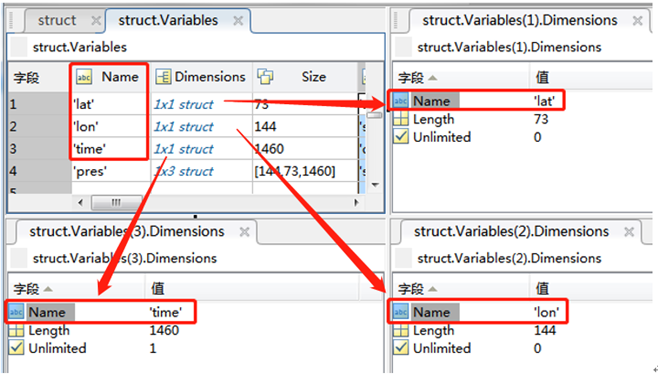
l It typically defines a physical coordinate corresponding to that dimension.
n So that you have alternative means of specifying position along the variable.
|
Index (C convention) |
0 |
1 |
2 |
3 |
4 |
… |
|
Index (Fortran convention) |
1 |
2 |
3 |
4 |
5 |
… |
|
physical coordinate (lat,lon,time etc.) |
0 |
2.5 |
5 |
7.5 |
10 |
… |
n Matlab netCDF functions adopt C convention such that the counting starts from zero. Diagram below illustrates the actual index that we should use to extract the data using the Matlab functions.
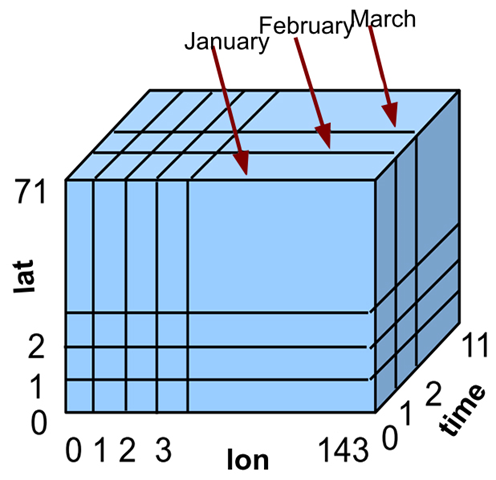
http://www.public.asu.edu/~hhuang38/matlab_netcdf_guide.pdf
Class Two: Primary variables
l This class can also be devied into two class:the Record variables and the others(just call it Fixed variables here)
l Record variables: these variables has the unlimited dimension(like time), their size is variable.
l Fixed variables: have a fixed size (number of data values) given by the product(叉乘、笛卡尔积) of its dimension lengths.
3.4 Groups
l Starting with version 4.0, groups can help organize data within a dataset.
l It’s not a type of data. Like a directory structure on a Unix file-system, the grouping feature allows users to organize variables and dimensions into distinct, named, hierarchical areas, called groups.
l Here we use the file “example.nc” to demonstrate the groups’ structure
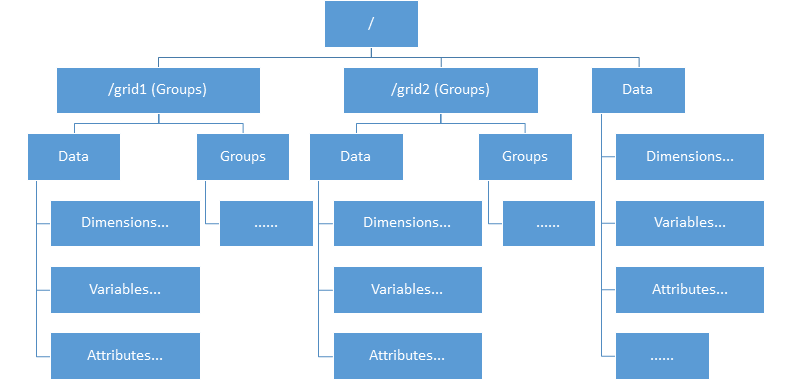
4. Source Code
After get know the file structure, we can extract the data of specific “variables”. Here illustrate the step of process.
Step 0: use function “ncinfo” or “ncdisp” to check the structure and information of the netCDF file; (this step is unnecessary if you have got known with the data.)
Step 1: Open the file;
Step 2: Extract data from specific “variables”;
Step 3: close the file;
4.1 Get data from netCDF file
% get information/structure data
struct = ncinfo('pres.tropp.2015.nc');
% open the file(pres.tropp.2015.nc) by Read-only access(NC_NOWRITE)
% ncid is a NetCDF file identifier
ncid = netcdf.open('pres.tropp.2015.nc','NC_NOWRITE');
% get variable ID(varid) by given its name(pres)
varid = netcdf.inqVarID(ncid,'pres');
% get data(pres_data) by specifying the variable ID(varid)
pres_data = netcdf.getVar(ncid,varid);
% clos the file
netcdf.close(ncid);
% clear defunct parameters, leave alone the data(pres_data)
clear ncidvarid

4.2 Get subset data of specified variable
The size of the “pres_data” matrix is 144×73×1460, what if I want to get the sub-matrix of “pres_data”?
Example 1: get the time series of a specified point (lon(11),lat(10))
ncid = netcdf.open('pres.tropp.2015.nc','NC_NOWRITE');
varid = netcdf.inqVarID(ncid,'pres');
series_data = netcdf.getVar(ncid,varid,[10,9,0],[1,1,1460]);
% "[10,9,0]" represent the start point (Again, remember that counting starts from zero.)
% "[1,1,1460]" specifies the amount of the data in each dimension.
% plot the data
% plot(series_data(:));
netcdf.close(ncid);
clear ncidvarid
series_data is still a 3-dimention matrix, and the first two dimentions’ length is 1. The relation between “series_data” and “pres_data” is below:
series_data(1,1,i) = pres_data(11,10,i),i=1,2,…,1460.
Example 2: get data of every point at time(0)
ncid = netcdf.open('pres.tropp.2015.nc','NC_NOWRITE');
varid = netcdf.inqVarID(ncid,'pres');
map_data = netcdf.getVar(ncid,varid,[0,0,0],[144,73,1]);
netcdf.close(ncid);
clear ncidvarid
map_data is a 2-dimention matrix. The relation between “map_data” and “pres_data” is below:
map_data(i,j) = pres_data(i,j,1),i=1,2,…,144;j=1,2,…,73
4.3 Plot a figure
% open the file
ncid = netcdf.open('pres.tropp.2015.nc','NC_NOWRITE');
% get data
map_data = netcdf.getVar(ncid,netcdf.inqVarID(ncid,'pres'),[0,0,0],[144,73,1]);
longitude = netcdf.getVar(ncid,netcdf.inqVarID(ncid,'lon'));
latitude = netcdf.getVar(ncid,netcdf.inqVarID(ncid,'lat'));
% Time = netcdf.getVar(ncid,netcdf.inqVarID(ncid,'time'));
% clos the file
netcdf.close(ncid);
% plot the data
map_data = map_data'; % map_data must be transposed(see below for details)
[x,y]=meshgrid(longitude,latitude);
pcolor(x,y,map_data);
colorbar('location','eastoutside');
shading interp;colormap parula
% clear defunct parameters
clear ncidxy
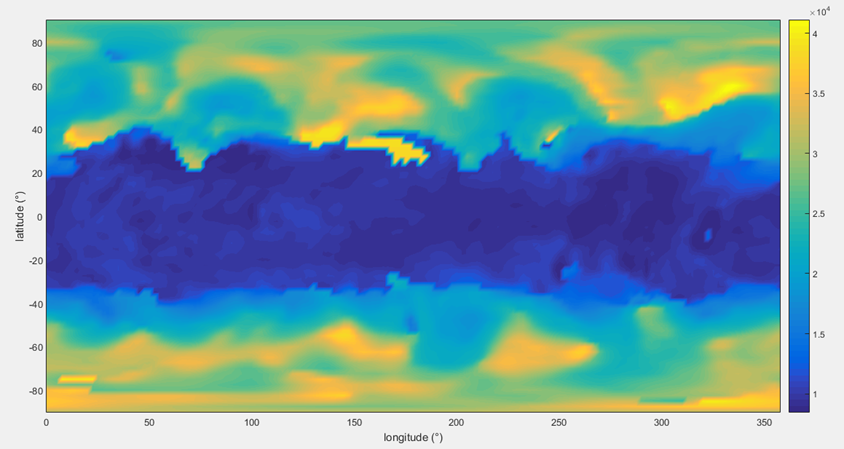
l Be careful when you plot the figure, the 1st dimension of the “map_data” is longitude, same as row of the matrix.
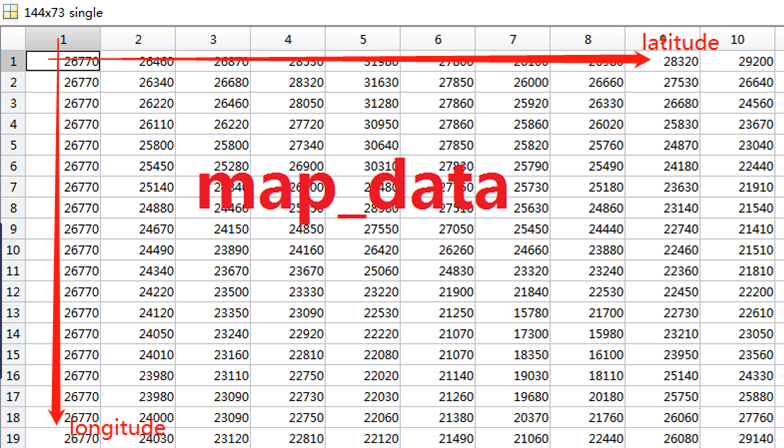
l The y-axis of the figure will be “longitude” if “map_dat” is not transposed.
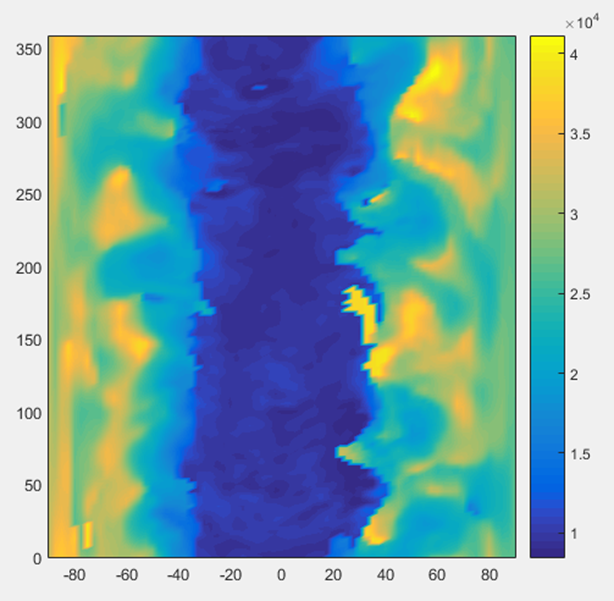
A quike guide teaching you how to use matlab to read netCDF file and plot a figure的更多相关文章
- ZooKeeper Getting Started Guide
http://zookeeper.apache.org/doc/trunk/zookeeperStarted.html What is ZooKeeper? ZooKeeper is a centra ...
- [C3] Andrew Ng - Neural Networks and Deep Learning
About this Course If you want to break into cutting-edge AI, this course will help you do so. Deep l ...
- GO语言的开源库
Indexes and search engines These sites provide indexes and search engines for Go packages: godoc.org ...
- Android Lint Checks
Android Lint Checks Here are the current list of checks that lint performs as of Android Studio 2.3 ...
- Matlab编程基础
平台:Win7 64 bit,Matlab R2014a(8.3) “Matlab”是“Matrix Laboratory” 的缩写,中文“矩阵实验室”,是强大的数学工具.本文侧重于Matlab的编程 ...
- LaTeX插入图片方法 Inserting Images
Inserting Images Images are essential elements in most of the scientific documents. LATEX provides s ...
- Machine Learning for hackers读书笔记(四)排序:智能收件箱
#数据集来源http://spamassassin.apache.org/publiccorpus/ #加载数据 library(tm)library(ggplot2)data.path<-'F ...
- 对于fmri的设计矩阵构造的一个很直观的解释-by 西南大学xulei教授
本程序意在解释这样几个问题:完整版代码在本文的最后. 1.实验的设计如何转换成设计矩阵? 2.设计矩阵的每列表示一个刺激条件,如何确定它们? 3.如何根据设计矩阵和每个体素的信号求得该体素对刺激的敏感 ...
- Go语言(golang)开源项目大全
转http://www.open-open.com/lib/view/open1396063913278.html内容目录Astronomy构建工具缓存云计算命令行选项解析器命令行工具压缩配置文件解析 ...
随机推荐
- [SHOI2009] 会场预约 - Treap
Description PP大厦有一间空的礼堂,可以为企业或者单位提供会议场地.这些会议中的大多数都需要连续几天的时间(个别的可能只需要一天),不过场地只有一个,所以不同的会议的时间申请不能够冲突.也 ...
- 如何在pycharm中使用配置好的virtualenv环境
1.手动建立: 第一步 建立虚拟环境 Windows cmd: pip install virtualenv 创建虚拟环境目录 env 激活虚拟环境 C:\Python27\Scripts\env\S ...
- c语言文件中关于while(!feof(fp)) 循环多输出一次的问题
文件中关于while(!feof(fp)) 循环多输出一次的问题 feof(fp)有两个返回值:如果遇到文件结束,函数feof(fp)的值为1,否则为0. 当读到文件末尾时,文件指针并没有 ...
- 聊聊Servlet、Struts1、Struts2以及SpringMvc中的线程安全
前言 很多初学者,甚至是工作1-3年的小伙伴们都可能弄不明白?servlet Struts1 Struts2 springmvc 哪些是单例,哪些是多例,哪些是线程安全? 在谈这个话题之前,我们先了解 ...
- python九九乘法表
j = 1 while j <= 9: i = 1 while i <= j: print("%d*%d=%d\t" % (i, j, i*j), end=" ...
- pyqt5 动画学习(二) 改变控件颜色
上一篇我们通过 self.anim = QPropertyAnimation(self.label, b"geometry")创建了一个动画,改变了空间的大小,这次我们来改变控件 ...
- 基于webpack的React项目搭建(三)
前言 搭建好前文的开发环境,已经可以进行开发.然而实际的项目中,不同环境有着不同的构建需求.这里就将开发环境和生产环境的配置单独提取出来,并做一些简单的优化. 分离不同环境公有配置 不同环境虽然有不同 ...
- [SHOI2008]小约翰的游戏John
Description 小约翰经常和他的哥哥玩一个非常有趣的游戏:桌子上有n堆石子,小约翰和他的哥哥轮流取石子,每个人取 的时候,可以随意选择一堆石子,在这堆石子中取走任意多的石子,但不能一粒石子也不 ...
- [AHOI2012]铁盘整理
题目描述 输入输出格式 输入格式: 共两行.第一行为铁盘个数N(1<=N<=50),第二行为N个不同的正整数,分别为从上到下的铁盘的半径R.(1<=R<=100) 输出格式: ...
- 【BZOJ1059】【ZJOI2007】矩阵游戏
Description 小Q是一个非常聪明的孩子,除了国际象棋,他还很喜欢玩一个电脑益智游戏――矩阵游戏.矩阵游戏在一个N*N黑白方阵进行(如同国际象棋一般,只是颜色是随意的).每次可以对该矩阵进行两 ...
